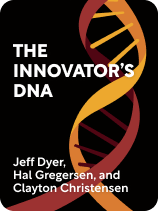

This article is an excerpt from the Shortform book guide to "The Innovator’s DNA" by Jeff Dyer, Hal Gregersen, and Clayton Christensen. Shortform has the world's best summaries and analyses of books you should be reading.
Like this article? Sign up for a free trial here.
What’s QuestionStorming? How can it unlock ideas and solutions you’d never find otherwise?
In The Innovator’s DNA, Hal Gregersen, Jeff Dyer, and Clayton Christensen identify five key skills that are shared by the world’s most innovative business leaders. One of these skills is questioning, and the authors recommend a technique called QuestionStorming to develop and implement this skill.
Read more to learn how you can use QuestionStorming to find innovative solutions.
QuestionStorming
The authors write that innovation is the key to success in today’s business environment, and the key to innovation, in turn, is creative thinking. The authors describe five behaviors and skills—what they call Discovery Skills—that are most likely to generate creative ideas. These are associative thinking, questioning, observing, idea networking, and experimenting. Let’s hone in on the skill of questioning and then explore the fun and effective exercise of QuestionStorming.
Asking questions improves your associative thinking by helping you gather crucial information about the status quo and then imagining new connections, possibilities, and directions for radical change. The authors’ research found that innovators not only asked more questions, they asked more disruptive questions—ones that challenged assumptions and looked at established products, services, and processes from new angles.
To strengthen your questioning skills and provoke deeper inquiries about the root causes or core elements of a problem try an activity called QuestionStorming. The authors lay out the following steps for this exercise that you can do either alone or with your team.
- Identify the problem.
- Brainstorm questions about the problem. Come up with at least fifty questions. Don’t discuss solutions yet—only questions.
- Write questions one at a time. If working with a team, write them where everyone can see them, like on a whiteboard (this helps to build on prior questions).
- Prioritize and reflect on (or discuss with your team) the most important and exciting questions.
- Attempt to answer the most important questions before moving on to brainstorming solutions.
(Shortform note: The authors suggest that QuestionStorming is superior to traditional brainstorming, which focuses on generating answers and solutions. Other business experts agree and explain why: In traditional group brainstorming, people may feel hesitant to speak up because of fear that their ideas will be rejected or ridiculed. But question-based brainstorming can change the group dynamic by creating a safe space for anyone to offer a different perspective. People often feel more comfortable speaking up with questions which helps expand collective exploration. Also, QuestionStorming echoes a technique used for millennia by rabbis and rabbinical students to deeply understand scriptural passages.)

———End of Preview———
Like what you just read? Read the rest of the world's best book summary and analysis of Jeff Dyer, Hal Gregersen, and Clayton Christensen's "The Innovator’s DNA" at Shortform.
Here's what you'll find in our full The Innovator’s DNA summary:
- The five key skills that are shared by the world's innovation leaders
- Why innovation in business is so important
- How to sustain innovative organizations and teams long term






